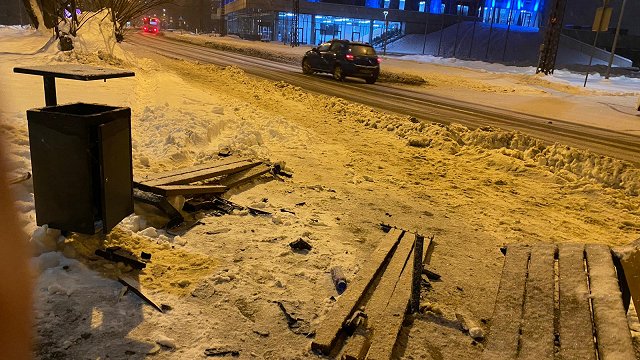Three years ago, the Estonian border guard managed to film the moment when a drone flew towards the Estonian city of Narva from the Russian side of the border and dropped a package of drugs. Unmanned aerial vehicles of unknown origin have also been seen around critical infrastructure facilities in Estonia.
The Minister of the Interior of Estonia, Lauri Läänemets, believes that via this method, Russia carries out espionage. In an interview with De Facto, the minister said: "We know for sure that Russia uses drones to gather intelligence, to determine our methods of action and preparation. When it comes to hybrid attacks and our national security situation, it would be naive to assume that Russia will abandon the use of drones ."
In March this year, only every fifth drone seen in the air had a coordinated flight plan.
A notable incident a few years ago was when a drone was caught carrying smuggled cigarettes and it turned out to have made almost 50 flights across the border before ending up in the hands of border guards.
Drones can transport not only contraband and drugs, but also weapons or electronic jamming equipment. Hacking or espionage attempts can also be targeted. And even if Estonia were to fully protect its border, there are no guarantees that Russian drones will not penetrate through other neighboring countries such as Latvia. These considerations have led the Estonian border guard to advance the idea of building a so-called 'drone wall' involving all countries bordering Russia and Belarus.
Veiko Kommusaar, deputy director of the Estonian Police and Border Guard Board, told De Facto that different detection systems should be used against different drones. "If the drone uses radio frequencies, then you have to use radio frequency detection. If it's guided by GPS, you have to use technologies that allow you to recognize it. And of course, acoustic and camera systems that can show them on the screen. It's different, complex systems that we need now. But we understand that the first need is to find a solution as soon as possible for those flying objects that use radio frequency," he said.
Accordingly, prices for various drone detectors vary from 50 thousand to half a million euros for one system. The Minister of the Interior of Estonia believes that it is necessary to be able to detect even those aircraft that are just approaching the border, so the radars should also be able to see a certain distance in the territory of Russia.
"The more difficult part is bringing down the drones. This could be done with laser weapons or more traditional weapons. One of the techniques used in Ukraine is 'drone nests', that is, sending a drone to shoot down another detected drone," said Estonian Minister of the Interior.
Estonians have already estimated the cost of such an anti-drone system in their country – it would be 12 million euros in the first stage and 50 million in total. Establishing a common defense would take at least five years. Estonia wants to introduce such a system that would also protect the largest populated areas.
Good idea, but...
At the end of May, the Minister of the Interior of Estonia presented the idea to his colleagues from the other Baltic states, as well as Norway, Finland and Poland. In official statements, the idea gained support, but unofficially there are concerns about a poorly prepared project.
None of the ministers of internal affairs of the participating countries responded to the De Facto request for a remote interview.
Dimitrijs Trofimovs, State Secretary of the Ministry of the Interior of Latvia, admitted that the primary goal is to create a system at the national level in cooperation with the Ministry of Defense. "Of course, the cooperation of the common region is also [important], because it is clear that the technical solutions and platforms will differ. Therefore, of course, it is an exchange of information about the best practice and the possibility of applying it, borrowing and implementing it in Latvia or vice versa, handing it over to someone else," he said.
Parliamentary Secretary of the Ministry of Defense Atis Švinka (Progressives) believes that for now the idea is only at the initiative level, but "practical actions must follow".
The Estonians hope that they could create an international joint project and apply for European Union funding. The head of the Latvian border guard is not so optimistic about this issue.
Security expert Rainer Saks (Estonia) believes that the "drone wall" should not be perceived as a short-term project, but the development of new capabilities for a long time. "I wouldn't say it's a bad idea. It's a very good idea, but I'm skeptical about it - there are so many different countries at the table. Can we really go ahead and do it sustainably? Even in the case of Rail Baltica, it's a problem, although there is an easier to understand standard. As can be seen, the three countries do not show the best cooperation in this area," said the expert.
Latvia is also aware of the threat of drones used by its eastern neighbors. According to the data of the border guard, two violator drones were found in 2022 and the same last year. The head of the State Border Guard, Guntis Pujāts, said that "unmanned aerial vehicles can be used by Russia and Belarus to obtain information about the location of objects of Latvian institutions. Accordingly, such risks are quite high".
The head of the Border Guard revealed that there have been attempts by Russia to take control of Latvian drones. However, previous programming work and precautions have not allowed this to be done successfully.
The Border Guard has been actively working on strengthening anti-drone capabilities for several years. Until now, border guards could shoot down violators' aircraft with a firearm. This year, 15 structural units of the border guard were equipped with equipment that allows detecting the appearance of unmanned aerial vehicles and taking them under their control. European funding was used for this, worth 1,672,341 euros. This year, procurement is being prepared for the purchase of dozens more pieces of equipment worth a total of two million euros.
There are as yet no estimates as yet of how much the "drone wall" would cost in Latvia.































